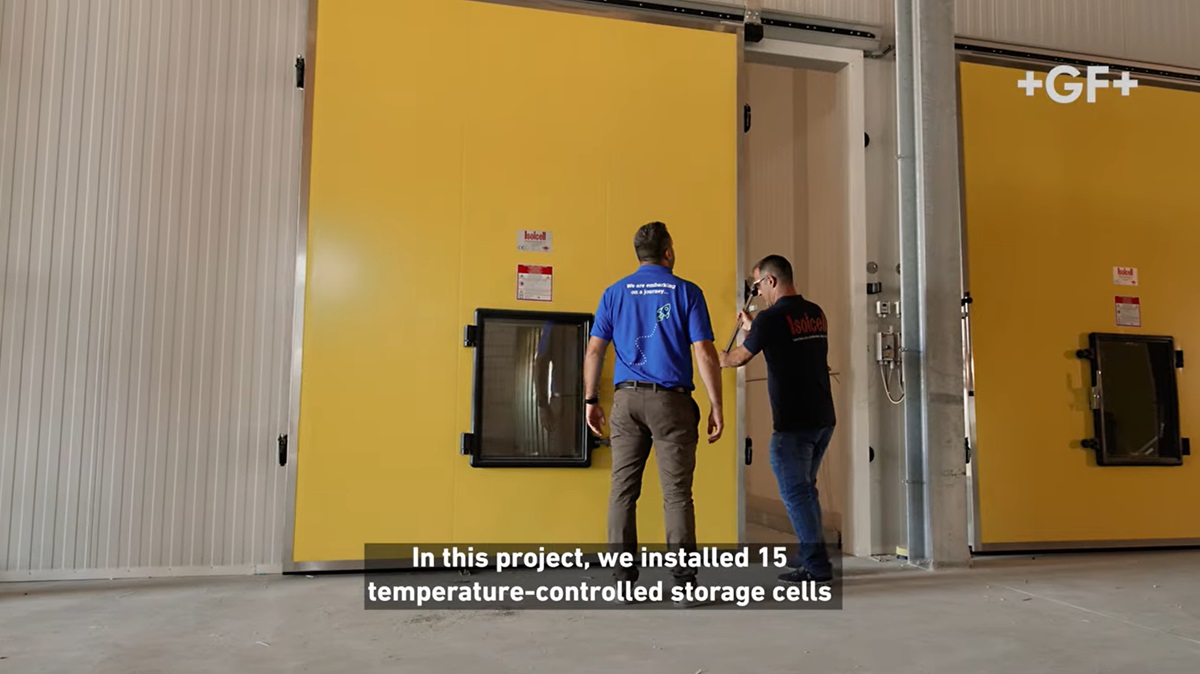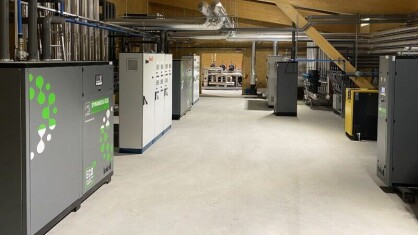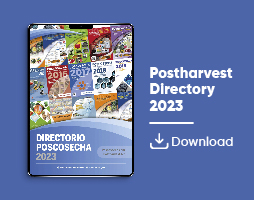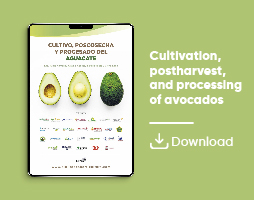Cooling and CA
Australia fruit industry with DCA, an effective way to keep apples and pears in good condition for longer without the need for chemical products
With consumers demanding more chemical-free food products, Dynamic Controlled Atmosphere (DCA) storage, which combines low oxygen with careful monitoring of fruit stress, offers an effective way to keep apples and pears in good condition for longer without the need for chemical products. Storing apples and pears for up to 12 months in controlled atmosphere stores so fruit can be sold all year round is now standard industry practice. Since the 1960s when this technology was widely adopted, commercial fruit storage facilities have also incorporated other new innovations into their practices, such as fruit maturity monitoring, nitrogen
30 November, -0001
With consumers demanding more chemical-free food products, Dynamic Controlled Atmosphere (DCA) storage, which combines low oxygen with careful monitoring of fruit stress, offers an effective way to keep apples and pears in good condition for longer without the need for chemical products. Storing apples and pears for up to 12 months in controlled atmosphere stores so fruit can be sold all year round is now standard industry practice. Since the 1960s when this technology was widely adopted, commercial fruit storage facilities have also incorporated other new innovations into their practices, such as fruit maturity monitoring, nitrogen generators, atmosphere monitoring and control, postharvest fungicides, DPA and, more recently, SmartFreshTM. Researchers continue to develop new management tools to aid in reliable, cost-effective marketing of fruit, and cool room managers need to keep a constant eye on new developments. Alternatives neededA major problem with long term storage of apples is the development of superficial scald on the fruit. This has been controlled by ethoxyquin or DPA and more recently by SmartFresh. SmartFresh has radically changed fruit storage, but it is not currently certified by the organic movement and consumers are becoming increasingly concerned about chemicals, such as DPA, on fruit, and are seeking a no chemicals approach to production and distribution. In many developed markets, such as the United Kingdom and Europe, supermarkets are responding to this by dictating residue levels well below those officially allowable. As a result, apples in some of these markets are not allowed to be treated with DPA or to be waxed and there is a preference for fruit certified as organic. Even before the commercialisation of SmartFresh in Europe and North America in the 1990s, there was strong consumer demand for DPA-free fruit.Further evidence of consumer demand for chemical-free fruit comes from the USA where Alar®, a plant growth regulator, was banned on apples following consumer pressure despite science demonstrating it was safe (Smith and Raso, 1999).Hence there is a small risk that consumers could declare current storage methods as unsafe. If that happens, other methods of maintaining fruit quality, perceived as safe by consumers, could be needed by the industry to ensure market sustainability and continuity of fruit supply.Controlling scald with low oxygenIn last months Australian Fruitgrower, the article on ethylene production in apples highlighted that oxygen is required for fruit to produce the fruit ripening hormone ethylene and also to respond to it. In storage systems where oxygen is maintained as low as possible fruit can hold its condition without the use of DPA or SmartFresh because ethylene is controlled. However, apples and pears stored at these low oxygen levels are at risk of anaerobic respiration, which causes skin discolouration, internal breakdown and off aromas due to fruit fermentation.Dynamic Controlled Atmosphere (DCA) technology is a healthy, environmentally-friendly way to keep fruit fresh using low oxygen levels to prevent the development of scald.DCA works by monitoring the stress level of the fruit in storage and adjusting the oxygen (O2) and carbon dioxide (CO2) levels to maximise fruit storage potential while maintaining sound, marketable fruit.The role of ethanolIn the early 1990s, monitoring of ethanol, produced as a result of anaerobic respiration, in ultra low CA rooms was studied for its potential to indicate minimum acceptable oxygen levels. In these studies Schouten et al (1997) report that Elstar apples were stored for seven months under recommended ultra low oxygen conditions (1.2% O2 + 2.5% CO2 at 1°C) or under a dynamic system where after ethanol appeared, O2 was adjusted to maintain ethanol below 1ppm in the atmosphere. After studying fruit quality, this research highlighted the potential for dynamic systems to outturn superior quality fruit. For example, across the 4 test orchards and two fruit maturities it was found that the average firmness of fruit under DCA was increased from 5.7 to 6.3kg after 7 months of storage and 10 days at room temperature.The potential of using ethanol in the storage atmosphere as a means of determining the minimum tolerable oxygen level in the CA room was confirmed in 2003 by Veltman et al. Again using Elstar apples it was found that the fruit from 15 orchards stored using a dynamic system, were firmer (the dynamic system increased firmness from 4.5 to 5.2kg after 7 months of storage and 2 weeks at room temperature), had better colour and had fewer skin spots compared with traditional CA-stored fruit.Of interest for growers with ethylene monitoring equipment, is that in rooms where you have accidently achieved very low levels of oxygen the level of ethylene appears to slightly increase. As most ethylene sensors are also very sensitive to ethanol you were probably observing ethanol production from the fruit rather than ethylene.While dynamic systems using ethanol have been known for some time, its commercial application has not eventuated. This may be due to a lack of equipment to sensitively and accurately measure ethanol in the presence of ethylene, a slow response time for the production of sufficient ethanol to be measured and production of ethanol by some fruit even in ambient air. As such, a faster and more discriminating measurement system is needed for dynamically-controlled oxygen levels in the CA storage room.Chlorophyll fluorescenceWhen chlorophyll, present in fruit skins, is initially exposed to light it becomes energised, but the cell is not fast enough or ready to chemically convert the energy to sugar. Instead, the light is re-emitted, apparent as fluorescence. This fluorescence can be easily and rapidly detected with specialised measuring equipment.The usefulness of this equipment for determining the cold tolerance in plants was studied here in Australia by Smillie and Hetherington as early as 1983 where they were interested in the tolerance of tropical crops to cold climates. Smillie continued with this research and in 1992 published a study that showed that chlorophyll fluorescence could be used to detect early symptoms of heat stress in fruit as the result of postharvest heat treatments to disinfest fruit of insects.In the 1980s, Robert Prange, at the Atlantic Food and Horticulture Research Centre of Agriculture and Agri-Food Canada, was researching water and heat stress effects on chlorophyll fluorescence and realised the potential of chlorophyll florescence as a means to monitor low oxygen stress of fruit in controlled atmosphere storage. In 2001 he patented and started commercialisation of HarvestWatch equipment for use in DCA storage systems.The fluorescence of apples remains relatively stable as the oxygen in the atmosphere is reduced to 0.8% and then, when it is reduced to 0.2%, the fluorescence dramatically and rapidly (within seconds) increases from 1,600 to 2,200 units indicating that the fruit has started anaerobic respiration and is now stressed by a lack of oxygen. Note that when the oxygen is increased to a safe level after this stress the fluorescence rapidly returns to normal indicating fruit recovery. As such it is possible to reduce oxygen until stress is observed and then lift the oxygen just a little above this level. Interestingly, HarvestWatch can also be used to detect other storage stresses such as the minimum temperature for fruit storage, although the equipment is optimised for oxygen management in the storage room.Establishing the use of DCADue to the consumer boycott of DPA and lack of alternative methods of controlling superficial scald in the early 2000s in Europe, the use of HarvestWatch as part of the DCA system was established especially in Northern Italy under the guidance of Angelo Zanella at the Laimburg Research Centre.Zanella et al (2005) reports on research where Granny Smith apples from 23 orchards were stored in a 150 tonne room using DCA. For comparison, samples of the fruit were also stored under ultra low oxygen conditions (1:1% CO2:O2) and at this same atmosphere, but after treatment with SmartFresh. The effects on superficial scald, quality and flavour were assessed after 6 months of storage followed by 7 days at 20°C and at 14 days at 20°C after storage when a bin of fruit from each of the 23 orchards was sorted on a commercial grader for superficial scald.This research showedthat DCA totally prevented the appearance of superficial scald, even after 7 days at 20°C, while close to 70% of the fruit had the disorder in fruit stored at ultra low oxygen levels (Figure 2). These results reflected the findings for all 23 lines of fruit assessed after 14 days at 20°C where almost no scald was encountered in all lines. Hence DCA is as effective as SmartFresh at preventing the appearance of superficial scald.It was also found that while the ultra low oxygen-stored fruit softened rapidly after storage the DCA fruit underwent similar softening to the SmartFresh fruit preserving the fruit quality during the marketing of the fruit to the consumer.An experienced panel of 29 people preferred SmartFresh fruit for its crunchiness although they preferred the DCA fruit for its flavour.The success of DCA in North America and Europe can be assessed by the level of adoption of the technology by industry. In 2010 it was estimated that there were 400,000 bins of fruit stored under DCA and that the number of bins being stored with this technology was increasing at 40% per annum (Prange et al 2010).According to HarvestWatch, currently there are more than 300,000 tonnes of fruit being stored in over 1,200 stores.The patented DCA system using HarvestWatch is globally marketed through Isolcell Italia as ISOSTORE®. On their website they say that in 2012,
more than 800 operational storage rooms are now to be found both in Italy and abroad (Argentina, Chile, Brazil, U.S.A., Germany, Austria, Slovenia, Croatia, Israel, France, Spain and Portugal)
and that ISOSTORE® is recognized by leading industry experts as the most suitable biological and natural alternative to DPA and 1-MCP use for the conservation of apples and pears.DCA in AustraliaThe HarvestWatch system was investigated by CSIRO at North Ryde in the early 2000s (Stephens and Tanner 2005) and confirmed the above research, yet no adoption of the system occurred in Australia as a result.Isolcell have just opened an agency in Australia and they hope to demonstrate DCA to industry in Victoria during the 2014 season. Robert Prange will also be in Australia in August to discuss the DCA system with growers. For more information go to www.harvestwatch.net and/or contact Mark Novotsky (novotnyz@bigpond.com, tel. 0438 220 680).ReferencesPrange, R. DeLong, J. Daniels-Lake, B and Harrison, A. 2005. Innovation in controlled atmosphere technology. Sterwart Postharvest Review. 1:3 1-11.Prange, R. DeLong, J. and Wright, A. 2010. Chlorophyll Fluorescence: Applications in Postharvest Horticulture. Chronica Horticulturae 50:1 13-16.Schouten, S. P.; Prange, R. K.; Verschoor, J.; Lammers, T. R. and Oosterhaven, J. 1997. Improvement of quality of Elstar apples by dynamic control of ULO conditions. Postharvest Horticulture Series Department of Pomology, University of California 16 71-78.Smillie, R.M. 1992. Calvin cycle activity in fruit and the effect of heat stress. ScientiaHorticulturae 51:1-2 83-95Smillie, R. M.; Hetherington, S. E. 1983. Stress tolerance and stress-induced injury in crop plants measured by chlorophyll fluorescence in vivo. Chilling, freezing, ice cover, heat, and high light. Plant Physiology 72:4 1043-1050.Smith, K. and Raso, 1999. An Unhappy Anniversary: The Alar Scare Ten Years Later.American Council on Science and Health. http://www.soc.iastate.edu/sapp/alar2.pdf accessed February 2014.Stephens, B. and Tanner, D. (2005) The harvest watch system measuring fruits healthy glow. Acta Horticulturae 687 363-364.Veltman, R. H.; Verschoor, J. A. and Dugteren, J. H. R. van 2003 Dynamic control system (DCS) for apples (Malus domestica Borkh. cv Elstar): optimal quality through storage based on product response. Postharvest Biology and Technology 27: 1 79-86.Zanella, A. Cazzanelli, P. Panarese, A. Coser, M. Cecchinel, M. and Rossi, O. 2005. Fruit Fluorescence Response to Low Oxygen Stress: Modern Storage Technologies Compared to 1-MCP Treatment of Apple. Acta Hort. 682 1535-1542.Source and original titleDynamic Controlled Atmosphere storage, Posted on March 31, 2014 The pictures show different views of DCA coldstores and the associated technology; the source is Isolcell´s web site. The last image is the source of all this information. Key wordsPoscosecha postcosecha postharvest na-oes ?? ??? ?????? ?? post-récolte ???? ?? ????????? na-oogst post-raccolta Obróbka po pós-colheita ?????????????? hasat sonras? Ernte ?????????????? ???? ??????????? postcollita poskliz?ové ?? ?? ? nakon branja pozberové obdelovanje zemlje po post-colleita ????? ????? pascapanen Éilíonn postharvest ???? p?c ra?as derliaus apdirbimas po lepas tuai ?? ?? ?????? post-recoltare ?????? ????? ????????????????? ??????????? ??????????????? sau thu ho?ch ??????????????? zangemva kwenkathi yokuvunaManzana apple ????? ?? pomme ???? ??? appel mela jab?ko maçã ?????? elma ???? Pera pear peer ????? ? poire ?????? ??????? gruszka pereira ????? armut











